 Process
Process Process
ProcessLocation: Theme Types dialog > Operation tab > Process
Availability: Map Modeller
Note: A Process Theme example is shown at the end of this topic.
The Process theme applies Processing to items before they are drawn.
Click Add Theme [Home-Map] or highlight the SIS Workspace Definition (SWD) in the Maps Control Bar and select Add Theme...

If the SWD contains more than one overlay the following Theme Overlay dialog will be displayed:
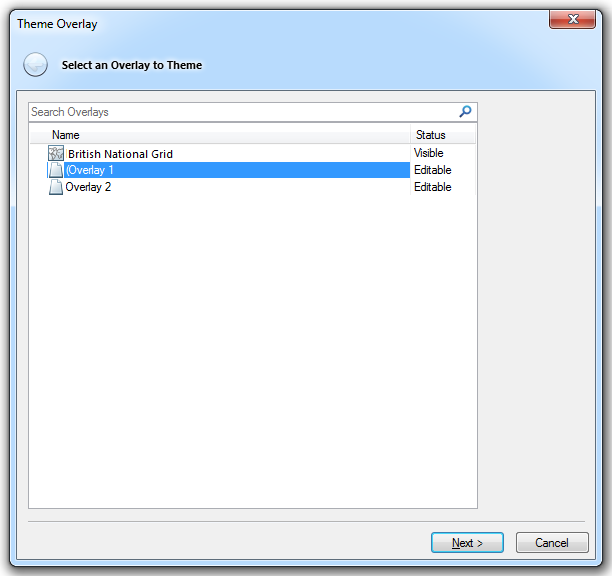
Either double-click the overlay to theme or select it and click Next.
The Theme Types dialog will now be displayed:

Go to the Operation tab and either double click the Process icon or select it and click Next.
The Processing Steps dialog will be displayed:
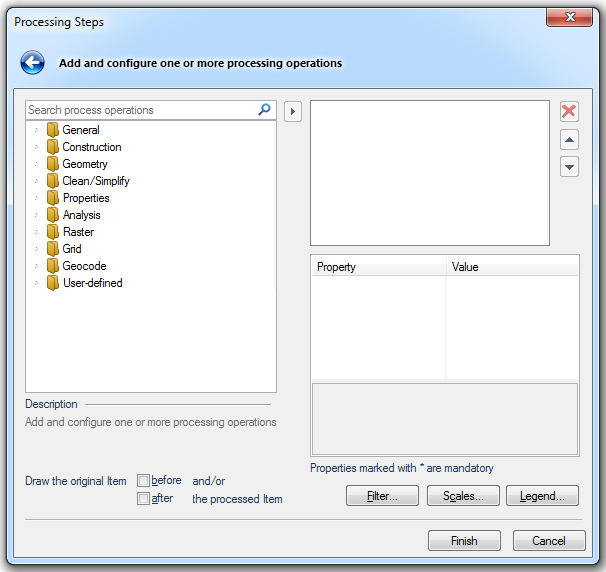
Select the required process operation from the appropriate folder in the left hand pane and click the right-arrow button to show the selected process in the right-hand pane. The parameters associated with the process are then shown in the right-hand lower pane. Enter the value(s) for the process, some processes do not require any inputs.
The Draw the original Item - before and after tickboxes control the drawing order in relation to the processed Item.
When this dialog is complete click Finish.
The processing operations are categorised as shown below. Click on the category title, or the individual process, to go to the page containing the process descriptions.
Notes:
Properties marked with an * in the process descriptions are mandatory.
Operations shown in light grey in the following list are not used by the Process Theme. The Process Theme can only use operations that take a single Item in, and pass a single Item out. They also cannot use operations that have an Overlay as a parameter, for example the Geometry 'Clip' operations.
| Copy | Copies an existing Item |
| Decompose | |
| Filter | |
| Group by | |
| Sort |
| Create box | Creates a rectangular Polygon, around a centre point |
| Create ellipse | Creates an elliptical Polygon |
| Create line (bearing/distance) | Creates a LineString from a bearing and distance |
| Create point | Creates a Point Item |
| Create points in Polygon | |
| Create points on LineString | |
| Create sector (bearing/angle) | Creates a sector Polygon from a bearing and angle. |
| Create sector (start/end) | Creates a sector Polygon from a start and end angle |
| Join points | |
| Join points (advanced) |
| Boundary | Gets the boundary of an Item. |
| Clip inside | |
| Clip outside | |
| Close | Closes any open geometry, joining the end to the start |
| Convex hull | Creates a convex hull Polygon around an Item |
| Envelope | Creates an envelope Polygon around the extents of an Item |
| Explode parts | |
| Explode segments | |
| Explode vertices | |
| Facet | Facets curved geometry segments into a straight geometry |
| Fill | Fills the boundary of an Item |
| Join LineStrings | |
| Move | Moves an Item in X and/or Y and/or Z |
| Remove interior loops | Removes interior loops (holes and islands) from Polygons, leaving only exterior loops |
| Reverse geometry | Reverses the geometry of an Item |
| Rotate | Rotates the geometry of an Item about a hook point |
| Scale | Scales the geometry of an Item about a hook point |
| Smooth (mid-points) | Smoothes the geometry of an Item, keeping segment mid-points fixed |
| Smooth (vertices) | Smoothes the geometry of an Item, keeping vertices fixed |
| Strip geometry | Strips the geometry of an Item, leaving an Empty Item |
| Generalise (Douglas-Peucker N) |
Generalises geometry using a variation of the Douglas-Peucker algorithm that is limited by the number of output points |
| Generalise (Douglas-Peucker) |
Generalises geometry using the Douglas-Peucker algorithm |
| Generalise (Perpendicular Distance) |
Generalises geometry using the Perpendicular Distance algorithm |
| Generalise (Radial Distance) |
Generalises geometry using the Radial Distance algorithm |
| Generalise (Reumann-Witkam) |
Generalises geometry using the Reumann-Witkam algorithm |
| Remove duplicates
(by expression) |
|
| Remove duplicates
(by geometry) |
|
| Remove self-intersections | Removes self-intersections, e.g. a bow-tie |
| Remove short segments | Removes segments shorter than a tolerance |
| Remove spikes | Removes vertices that cause a spike |
| Remove straight segments | Removes vertices between straight, or near straight segments. |
| Simplify | Simplifies the geometry of an item, so that it matches the OGC 'simple' form |
| Remove all attributes | Removes all attributes from an Item |
| Remove attribute | Removes an attribute from an Item |
| Set property | Sets a property on an Item |
| Set styles | Sets styling information on an Item |
| Strip styles | Strips all styling information from an Item. Returns Brush, Pen and Symbol Items to "By Overlay" |
| Buffer | Creates a buffer around an Item |
| Cluster | |
| Create Thiessen Polygons | |
| Dissolve | |
| Geodetic buffer | Creates a 'geodetic' buffer around an Item |
| Intersect | |
| QZone buffer | Creates a QZone buffer around an Item |
| Subtract | |
| Symmetric difference | |
| Union | |
| Viewshed (as Grids | |
| Viewshed (as QZone) | |
| Viewshed (as binary Grids) |
| Compress | Compresses a bitmap |
| Convert to grayscale | Converts a colour bitmap to a grayscale bitmap |
| Convert to sepia | Converts a colour bitmap to a sepia bitmap |
| Crop | Crops a bitmap |
| Create Terrain Ruggedness Index | Creates a Terrain Ruggedness Index map |
| Create Topographic Position Index | Creates a Topographic Position Index map |
| Create aspect | Creates an Aspect map |
| Create contours (fixed intervals) | |
| Create contours (fixed levels) | |
| Create hillshade | Creates a shaded relief map from a Grid |
| Create points | |
| Create polygon coverage | |
| Create polygons | |
| Create roughness | Creates a Roughness map |
| Create slope | Creates a Slope map |
| Set cell value | Sets the value of all Grid cells that match a comparison against the 'from' value to the 'to' value |
| MapQuest Open | Connects to the MapQuest Open Geocoding service |
| Microsoft Bing Maps | Connects to the Microsoft Bing Maps geocoding service |
| OS (GB) Code-Point Open | Searches OS (GB) Code-Point Open data, by postcode |
| OS (GB) National Grid Reference | Matches search strings against OS (GB) National Grid References |
| OS (GB) National Grid Reference (Jersey) | Matches search strings against OS (GB) National Grid References for Jersey |
| Remove all attributes | Removes all attributes from an Item |
| Strip styles | Strips all styling information from an Item |

Click here for a description of the functions of these three buttons.
If, for example, you want to display a symbol for traffic calming in the location of the speed bumps (black hatch pattern):
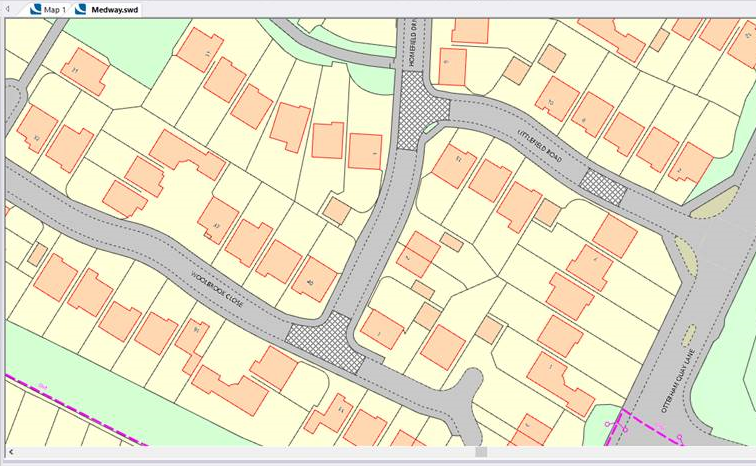
Create a process theme.
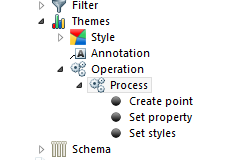
In this example the theme is made up of three processes;
Create point will create a point at a x,y,z location. In this example use _ox# and _oy#

The second process is to set up a property. In this example the symbol was too large so set the scale to .5, making it half the size.
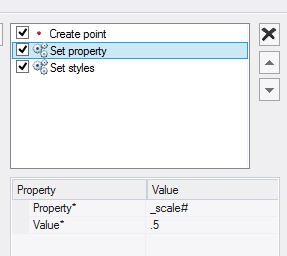
The last process sets the style of the symbol.

The Process Theme, as with other themes, can have a filter or scale threshold.
In this example use a filter so that symbols only appear for the “Traffic Calming”:

The result in the map is:
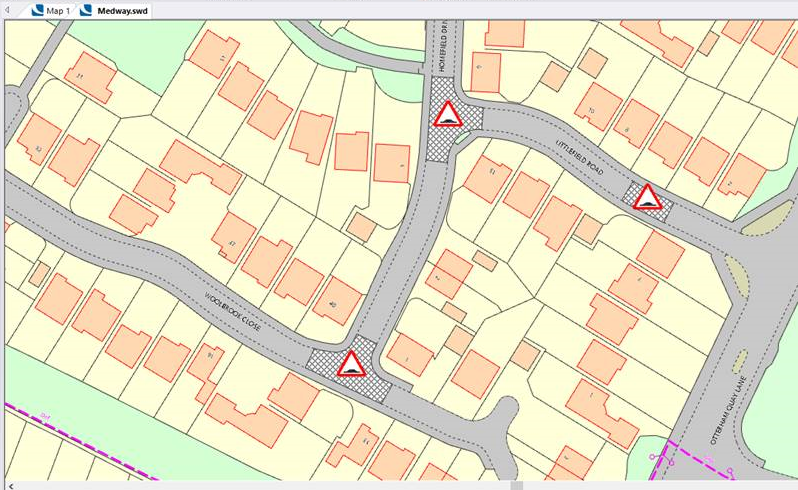
The relationship between the symbol and the hatch is dynamic. The theme can be stored in the NOL, like any other theme and reused again.
As an aside, the process can be used to create data. If you want to “convert” these areas to points, a similar process to this theme could be used to create an overlay of points.
Click here for Process Theme properties.
Send comments on this topic.
Click to return to www.cadcorp.com
© Copyright 2000-2017 Computer Aided Development Corporation Limited (Cadcorp).